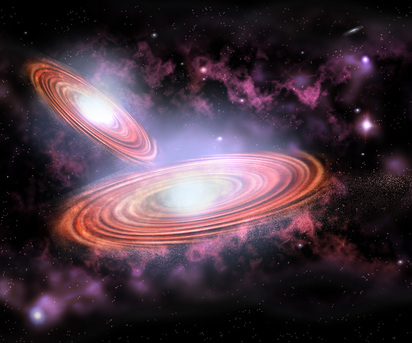Binary black hole
Random merger of two galaxies?
 © P. Marenfeld and NOAO/AURA/NSF
|
An artist’s impression of a supermassive binary black hole quasar. It moves with the mind blowing speed of 3700 miles per second.
“The double set of broad emission lines is pretty conclusive evidence of two black holes,” Boroson argues. “If in fact this were a chance superposition, one of the objects must be quite peculiar. One nice thing about this binary black hole system is that we predict that we will see observable velocity changes within a few years at most. We can test our explanation that the binary black hole system is embedded in a galaxy that is itself the result of a merger of two smaller galaxies, each of which contained one of the two black holes.”
Boroson and his colleague Tod Lauer analyzed the spectrums of some 17,000 quasars searching for characteristics of a binary black hole quasar. The supermassive black holes exert an unbelievably high gravitational pull with which they collect matter from their surroundings. The matter falling into the black hole doesn’t go directly in, but orbits around the black hole forming a flat accretion disc, much like the soap scum on water orbiting around an open drain. This process produces a lot of energy lighting the center of the galaxies as quasars.
Astronomers cannot observe accretion discs directly, since they are too close to the black holes. However their radiation can be detected as broad emission lines in the spectrum of the galaxy’s center. Since every black hole has its own accretion disc the scientists could observe a double set of broad emission lines. The smaller black hole has a mass 20 million times that of the sun; the larger one is 50 times bigger, as determined by their orbital velocities.
It might be the most interesting dance that astronomers will observe for a while.
Rainer Kayser is a journalist in Hamburg, Germany. Translation: Raphael Steinbach
Binary black hole
Random merger of two galaxies?
 © P. Marenfeld and NOAO/AURA/NSF
|
An artist’s impression of a supermassive binary black hole quasar. It moves with the mind blowing speed of 3700 miles per second.
“The double set of broad emission lines is pretty conclusive evidence of two black holes,” Boroson argues. “If in fact this were a chance superposition, one of the objects must be quite peculiar. One nice thing about this binary black hole system is that we predict that we will see observable velocity changes within a few years at most. We can test our explanation that the binary black hole system is embedded in a galaxy that is itself the result of a merger of two smaller galaxies, each of which contained one of the two black holes.”
Boroson and his colleague Tod Lauer analyzed the spectrums of some 17,000 quasars searching for characteristics of a binary black hole quasar. The supermassive black holes exert an unbelievably high gravitational pull with which they collect matter from their surroundings. The matter falling into the black hole doesn’t go directly in, but orbits around the black hole forming a flat accretion disc, much like the soap scum on water orbiting around an open drain. This process produces a lot of energy lighting the center of the galaxies as quasars.
Astronomers cannot observe accretion discs directly, since they are too close to the black holes. However their radiation can be detected as broad emission lines in the spectrum of the galaxy’s center. Since every black hole has its own accretion disc the scientists could observe a double set of broad emission lines. The smaller black hole has a mass 20 million times that of the sun; the larger one is 50 times bigger, as determined by their orbital velocities.
It might be the most interesting dance that astronomers will observe for a while.
Rainer Kayser is a journalist in Hamburg, Germany. Translation: Raphael Steinbach






